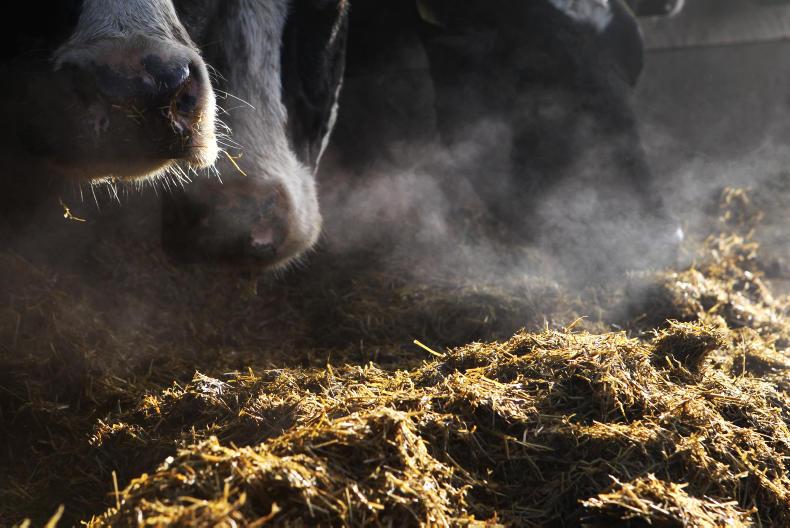Following prolonged unsettled weather, CAFRE beef and sheep technologists Dr Eileen McCloskey and Dr Norman Weatherup have warned of a potential shortage of fodder for some farms or poor-quality silage with low dry matter and metabolisable energy contents.
In some cases, due to limited supplies of forage being available or through a desire for enhanced animal performance, they say that a minimal forage diet may be fed. However, this approach should not be taken lightly and must be managed very carefully as there may be lethal consequences.
Ruminants require long, structural fibre in their diet for rumination (chewing). Normally it is recommended that 40% of the diet dry matter should be in the form of long roughage. Provided changes are made gradually, this can be reduced to 25% of the diet. Table 1 shows minimum forage requirements for a range of livestock.
Table 1. Minimum forage requirements of livestock presented in kg/day of fresh silage and hay/straw
| |
Minimum fresh silage (kg/day) | Minimum hay/straw (kg/day) |
Dairy cow (30 litres) | 23 | 5.5 |
Suckler cow (600kg) | 11 | 2.5 |
Store cattle (300-400kg) | 9 | 2 |
Ewe | 1.2 | 0.5 |
Intensively fed young bulls may have as little as 10% of their dry matter intake in the form of roughage.
Points to consider
The CAFRE technologists warn that this diet will require high levels of concentrate supplementation to meet the animals requirement particular attention must be taken to ensure:
Dietary changes are introduced very slowly to prevent stomach upsets.An appropriately balanced diet is provided to prevent issues such as acidosis.Forages available must be long, ie not finely chopped, to ensure rumen function is maintained.Forages available are analysed to allow careful selection of concentrates to meet requirements.Adequate feed space is available to ensure no individuals are under-fed.Adequate water must be available as the diet will be considerably drier at high concentrate levels.Straights and compounds are selected based on relative feed value to ensure value for money.An appropriate mineral balancer is fed as mineral content of concentrates may be very different from that of roughages.Restricting the amount of good quality silage fed and increasing the amount of concentrates will be more economical than purchasing poor quality forages at high prices.
Minimal forage diets from CAFRE may be necessary in some cases due to severe shortages.
There is potential for severe stomach upsets or even death of the animal if it is not managed carefully.
Young bulls, finishing steers and heifers within 100 days of finish and pregnant ewes are the most suitable groups of stock for minimal forage diets.
Read more
Five tips for ad-lib meal finishing
'It’s been winter since July… The situation is the worst I’ve ever seen it.'
Farmers delay buying stock due to fodder concerns
Following prolonged unsettled weather, CAFRE beef and sheep technologists Dr Eileen McCloskey and Dr Norman Weatherup have warned of a potential shortage of fodder for some farms or poor-quality silage with low dry matter and metabolisable energy contents.
In some cases, due to limited supplies of forage being available or through a desire for enhanced animal performance, they say that a minimal forage diet may be fed. However, this approach should not be taken lightly and must be managed very carefully as there may be lethal consequences.
Ruminants require long, structural fibre in their diet for rumination (chewing). Normally it is recommended that 40% of the diet dry matter should be in the form of long roughage. Provided changes are made gradually, this can be reduced to 25% of the diet. Table 1 shows minimum forage requirements for a range of livestock.
Table 1. Minimum forage requirements of livestock presented in kg/day of fresh silage and hay/straw
| | Minimum fresh silage (kg/day) | Minimum hay/straw (kg/day) |
Dairy cow (30 litres) | 23 | 5.5 |
Suckler cow (600kg) | 11 | 2.5 |
Store cattle (300-400kg) | 9 | 2 |
Ewe | 1.2 | 0.5 |
Intensively fed young bulls may have as little as 10% of their dry matter intake in the form of roughage.
Points to consider
The CAFRE technologists warn that this diet will require high levels of concentrate supplementation to meet the animals requirement particular attention must be taken to ensure:
Dietary changes are introduced very slowly to prevent stomach upsets.An appropriately balanced diet is provided to prevent issues such as acidosis.Forages available must be long, ie not finely chopped, to ensure rumen function is maintained.Forages available are analysed to allow careful selection of concentrates to meet requirements.Adequate feed space is available to ensure no individuals are under-fed.Adequate water must be available as the diet will be considerably drier at high concentrate levels.Straights and compounds are selected based on relative feed value to ensure value for money.An appropriate mineral balancer is fed as mineral content of concentrates may be very different from that of roughages.Restricting the amount of good quality silage fed and increasing the amount of concentrates will be more economical than purchasing poor quality forages at high prices.
Minimal forage diets from CAFRE may be necessary in some cases due to severe shortages.
There is potential for severe stomach upsets or even death of the animal if it is not managed carefully.
Young bulls, finishing steers and heifers within 100 days of finish and pregnant ewes are the most suitable groups of stock for minimal forage diets.
Read more
Five tips for ad-lib meal finishing
'It’s been winter since July… The situation is the worst I’ve ever seen it.'
Farmers delay buying stock due to fodder concerns






 This is a subscriber-only article
This is a subscriber-only article










SHARING OPTIONS: